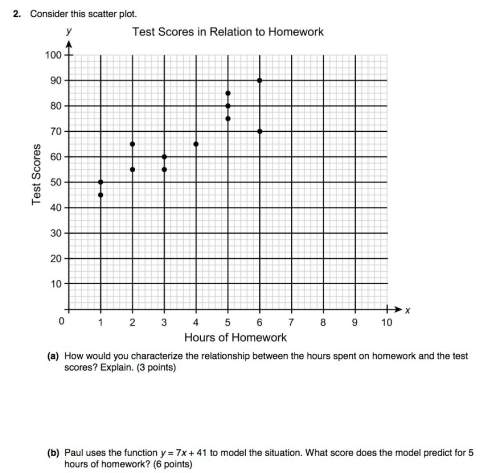6.3.4 journal: nonlinear models
scenario: rabbit population
show your work f...

Mathematics, 14.12.2019 03:31 ricardodeleon152
6.3.4 journal: nonlinear models
scenario: rabbit population
show your work for all calculations.
here are the data for the hypothetical (or imagined) rabbit population.
year (x) 0 1 2 3 4 5 6 7 8 9 10
number of rabbits (y) 6 8 10 14 19 25 33 43 57 77 104
1. looking at the data, does this rabbit growth look linear, quadratic, or exponential? explain your answer.
(1 point)
2. make a scatterplot for the data. (2 points)
3. looking at the scatterplot, which regression model do you think fits the data? explain your answer.
(1 point)
4. using a graphing calculator, find the quadratic regression equation for the rabbit data.
(2 points: 1 point for identifying constants, 1 for the equation)
5. using the quadratic regression equation from question 4, predict the number of rabbits in year 70.
(2 points: 1 point for setting up the correct equation, 1 for simplifying)
6. using a graphing calculator, find the exponential regression equation for the rabbit data.
(2 points: 1 point for identifying the constants, 1 for the equation)
7. using the exponential regression equation from question 6, predict the number of rabbits in year 70.
(2 points: 1 point for setting up the correct equation, 1 for simplifying)
8. compare the predicted number of rabbits for year 70 using the quadratic model (question 5) with the predicted number using the exponential model (question 7). which prediction is larger? (1 point)
9. is it reasonable to use this data set to predict the hypothetical number of rabbits for year 70? explain.
(1 point)
making a decision
10. these graphs show the scatterplot with the quadratic regression equation and the exponential regression equation.
a) which do you think is a better fit? why? (2 points: 1 point for choice, 1 point for explanation)
b) how does your answer to part (a) compare with your guess about the best model in question 1? was your initial choice correct? (1 point)
analyze your results
11. the video says there were an estimated 10 billion rabbits in australia after 70 years.
a) how does your predicted number of rabbits for the hypothetical population compare with the actual rabbit population in australia in year 70? (1 point)
b) why do you think the rabbit population in australia can grow so large? (1 point)
c) what are some factors that might prevent a rabbit population from growing infinitely large? (1 point)

Answers: 2


Another question on Mathematics

Mathematics, 21.06.2019 16:50
Factor -8x3-2x2-12x-3 by grouping what is the resulting expression?
Answers: 2

Mathematics, 22.06.2019 00:30
Intro biblioteca sunt 462 de carti cu 198 mai putine enciclipedii si cu 47 mai multe dictionare decat enciclopedii cate enciclopedii sunt in biblioteca
Answers: 1

Mathematics, 22.06.2019 02:30
(2, 4) (2, 1) (6, 12) (4, -5) (-2, 4) |(2, -4) (6, -12) (-4,5) quadrilateral abcd is reflected over the x-axis. quadrilateral abcd is translated 2 units right and 1 unit down. quadrilateral abcd is dilated by a scale factor of 3. quadrilateral abcd is rotated 180° clockwise about the origin. reset next
Answers: 3

Mathematics, 22.06.2019 04:30
Of the total number of spectators at a circus show, 1/4 are men. 2/5 of the remaining number of spectators are women. there are 132 women at the circus show. how many children are at the circus show?
Answers: 2
You know the right answer?
Questions

Physics, 18.09.2019 20:00

Mathematics, 18.09.2019 20:00

Mathematics, 18.09.2019 20:00



History, 18.09.2019 20:00

Mathematics, 18.09.2019 20:00

Biology, 18.09.2019 20:00

Mathematics, 18.09.2019 20:00


Mathematics, 18.09.2019 20:00


Mathematics, 18.09.2019 20:00

Mathematics, 18.09.2019 20:00


Mathematics, 18.09.2019 20:00

Mathematics, 18.09.2019 20:00


English, 18.09.2019 20:00





